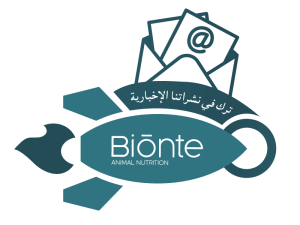Introduction
Ruminants are considered less susceptible to the effect of mycotoxins compared to other species. Biotransformation processes occurring in the rumen microbiota convert some of these substances into compounds that are less toxic to these animals (Xu et al., 2023). However, mycotoxins are still harmful to the production of this type of livestock, and the alteration of the ruminal environment can hinder the detoxification process (Álvarez-Días et al., 2022).
Some mycotoxicosis lead to diseases, either acute or chronic, with evident clinical signs and pathological changes. However, many mycotoxins affecting animals can cause subclinical conditions or reduced productivity, as well as carcinogenic, mutagenic, teratogenic, immunosuppressive and endocrine effects, that are challenging to diagnose.
Also, these diseases can negatively impact ruminant performance and productivity, resulting in reproductive issues, as well as immunosuppression (Álvarez-Días et al., 2022). A clear correlation has been established between the presence of mycotoxins in dairy cattle feed and adverse outcomes, including feed rejection, reduced milk production, diarrhea, and infertility (Ismail et al., 2020). The offspring of animals exposed to mycotoxins are also affected. In cattle exposed to aflatoxins, offspring have been found to be more susceptible to inflammatory processes and secondary infections. In addition, this type of mycotoxin causes liver and kidney damage (Álvarez-Días et al., 2022).
Aflatoxins
Aflatoxins represent a high risk in ruminants, especially in dairy cows, due to their demonstrated transfer to milk, either for human consumption or for calf feed (Hernandez-Valdivia et al., 2021). Aflatoxin B1 (AFB1) is the best known within this family. The effects after acute or chronic exposure include: liver fibrosis (cirrhosis) with proliferation of bile duct cells, megalocytosis, as well as biliary stasis and haemorrhagic liver (Image 1). In addition, other studies have documented how exposure to this mycotoxin can result in a pale tan-textured liver (Image 2); congestive liver and heart (Image 3) and haemorrhagic kidneys (Image 4) (Sajid Umar et al., 2015; Ismail et al., 2020; Álvarez-Días et al., 2022).
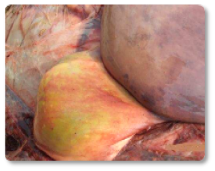
Image 1. Biliary stasis and hemorrhagic liver.
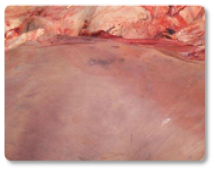
Image 2. Pale tan liver texture.
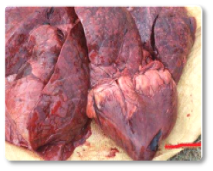
Image 3. Congestive heart and liver.
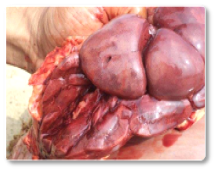
Image 4. Hemorrhagic kidneys.
In addition, AFB1 causes immunosuppression, which increases susceptibility to secondary infections and may affect productivity (Riet-Correa et al., 2013). Evidenced clinical symptoms include: inappetence, depression, diarrhea (Image 5) and epistaxis (Image 6) (Sajid Umar et al., 2015; Ismail et al., 2020; Álvarez-Días et al., 2022).
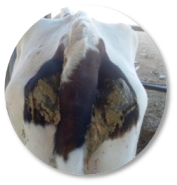
Image 5. Diarrhea.
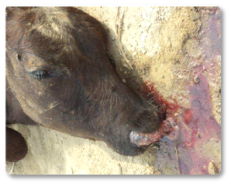
Image 6. Epistaxis.
Other authors have also described abortions and increased mortality (Image 7), as well as prolapses (Image 8) (McKenzie et al., 1981; Van Halderen et al., 1988; Felipe Penagos-Tabares et al., 2024).
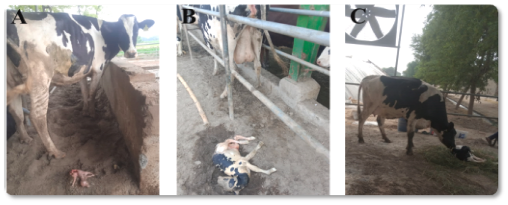
Image 7. Abortions at 100 days (A), 215 days (B) and 260 days (C) gestation.
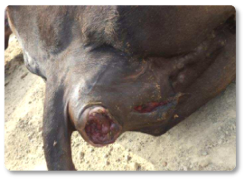
Image 8. Prolapse due to aflatoxicosis.
Zearalenone
As in other species, in ruminants, zearalenone (ZEN) mainly induces reproductive alterations. Its estrogenic effect can cause low fertility, vulva inflammation and alterations in the reproductive cycle (Hartinger et al., 2022). Milk production is also affected by this mycotoxin, with a decrease in milk yield, as well as alterations in milk quality (Ogunade et al., 2018). This mycotoxin can also trigger significant problems in males, with cases of sterility caused by its oxidative effect (Liu et al., 2023). Zearalenone also causes liver and kidney damage as well as pulmonary oedema (Hartinger et al., 2022). Rectal prolapse (Image 9), vulvar enlargement and uterine prolapse have also been reported in non-pregnant cows (Image 10).
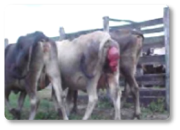
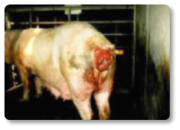
Image 9. Rectal prolapse.
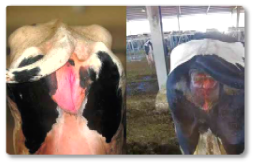
Image 10. Vulvar enlargement and uterine prolapse in non-pregnant cows.
Deoxynivalenol
Ruminants that do not suffer from any metabolic disorder or inflammatory process are able to inactivate significant amounts of deoxynivalenol (DON). However, the ruminal microbiota may be altered in case of impaired fermentation, defaunation or low ruminal pH (Whitlow and Hagler, 2007). In situations of high feed contamination, prolonged exposure or compromised defenses, DON can reduce dry matter intake, impair reproduction and alter immune system (Guerrero-Netro et al., 2021). Especially in calves, ingestion of DON-contaminated feed results in lower weight gain, lethargy (Image 11) and increased susceptibility to infectious diseases (e.g. diarrhoea, Image 12) (Panisson et al., 2023; Hasuda et al., 2022; Ogunade et al., 2018; Nagl et al., 2014; Heliez et al., 2009; Pinton et al., 2009; Mallmann et al., 2007).
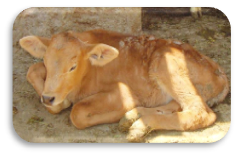
Image 11. Lethargy.
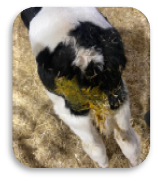
Image 12. Calf with diarrhoea.
T-2 toxin
T-2 toxin is one of the most toxic mycotoxins for ruminants. Cytotoxic and immunotoxic effects have been documented, as well as alterations in protein synthesis (including RNA and DNA), reproductive function and energy metabolism. In addition, T-2 toxin may cause tremors or paralysis of the hind limbs (Ogunade et al., 2018; Kemboi et al., 2020). Notable damage is frequently observed in the gastrointestinal tract (Images 13-14), blood vessels and heart (Image 15), bone marrow, liver, nervous system and mucous membranes (Images 16-17).
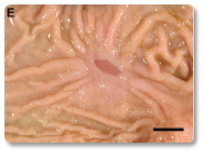
Image 13. Multifocal chronic ulcerative abomasitis.
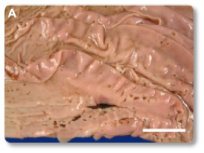
Image 13. Multifocal chronic ulcerative abomasitis.
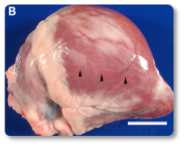
Image 15. Heart with multifocal fusing pale areas, myocardial fibrosis in right ventricle and apex.
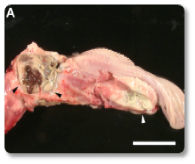
Image 16. Necrotizing and purulent multifocal stomatitis, affecting pharynx and tongue.
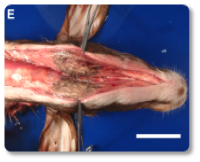
Image 17. Significant subcutaneous edema in the neck and submandibular region, and muscle necrosis.
Fumonisins
The fumonisin family is made up of more than 30 different types, among which the most studied act mainly by replacing sphingosine in biological reactions, which causes failures in the molecular structure (Fink-Gremmels, 2008). Primary damage appears to occur in the gastrointestinal tract, kidney and liver (Hartinger et al., 2022). These toxins have been associated with reduced dry matter intake and a higher risk of disease (Fink-Gremmels, 2008). While fumonisins are degraded in the rumen and minimally absorbed in ruminants, adverse effects such as reduced ruminal fermentation and microbiota disruption are more pronounced at high exposure levels or when combined with other toxins or stress factors (Gallo et al., 2020).
Ochratoxin A
Ochratoxin A (OTA) can cause kidney damage and failure (Image 18), oxidative stress and liver damage (Image 19), as well as immunosuppression. OTA may have synergistic effects with ZEN, exacerbating ZEN-induced reproductive disturbances.
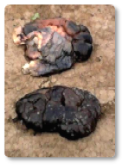
mage 18. Black kidneys, friable and autolytic.
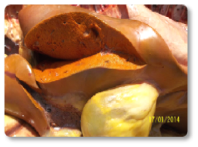
Image 19. Hepatitis, ocher liver with accident gallbladder, perivesicular emphysema.
Ergot alkaloids
Significant ergotism outbreaks in cattle and horses have been described in the 1990s following the feeding of wheat and oats infected with Claviceps purpurea (Ilha et al., 2003; Riet-Correa et al., 1988, 2013). In bovines, the intoxication was caused by the consumption of wheat bran, mainly presenting dystrophic syndrome. In addition, gangrenous ergotism, with loss of ear tips and tail tips (Images 20-21), lethargy (Image 22) and hyperexcitability (Image 21), were observed in cattle fed maize hay contaminated with C. purpurea-infected rye (Riet-Correa et al., 2013). Also, tremors affecting the neck and head, and episcleral congestion (Image 23) have been described (Riet-Correa et al., 2013).
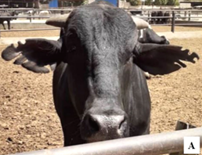
Image 20. Loss of ear tips.
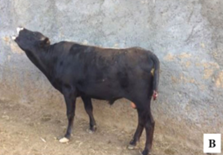
Image 21. Loss of tail tip and hyperexcitability
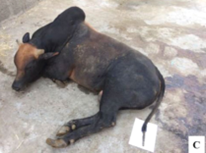
Image 22. Lethargy and loss of tail tip.
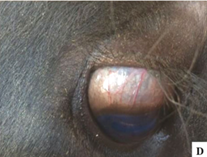
Image 23. Episcleral congestion.
Conclusion
The clinical symptoms of mycotoxins in ruminants are different and depend on the nature of the toxin, its concentration and the time of exposure. These substances can compromise animal health by causing metabolic disturbances, immunosuppression, liver damage, reproductive disorders and neurological effects. Early detection and proper management of contaminated forages are essential to minimize their impact and ensure animal welfare and livestock productivity.

